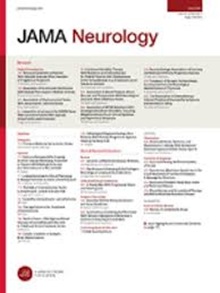Amyloid-Beta Pathology and Cognitive Performance in Centenarians
IF 21.3
1区 医学
Q1 CLINICAL NEUROLOGY
引用次数: 0
Abstract
ImportanceOlder individuals without dementia often have amyloid-beta (Aβ) Thal phases similar to patients with Alzheimer disease (AD), suggesting that Aβ pathology may be a benign consequence of aging.ObjectiveTo explore whether Aβ pathology in centenarians is associated with cognitive performance.Design, Setting, and ParticipantsThis longitudinal cohort study used cross-sectional data on antemortem cognitive performance and postmortem neuropathology of participants in the Dutch 100-plus Study. Cognitive performance was measured a median of 10 (IQR, 3-13) months before postmortem brain donation. From January 2013 to July 2022, 1187 centenarians who self-reported being cognitively healthy, confirmed by proxy, were approached: 406 were included and 95 donated their brain. Centenarians were compared with patients with clinicopathologically confirmed AD from the Netherlands Brain Bank. Data were analyzed from June 2022 to October 2024.Main Outcomes and MeasuresAβ pathology was assessed with the Thal phase for Aβ progression and by determining quantitative Aβ loads (percentage positive area) in the frontal, parietal, temporal, and occipital neocortices, 3 parahippocampal, and 5 hippocampal subregions. Aβ pathology was associated with performance on 13 neuropsychological tests assessing memory, fluency, attention/processing speed, and executive functioning, as well as 4 measures of global cognition.ResultsThis study evaluated Aβ pathology in 95 centenarians (median age at brain donation, 103.5 [IQR, 102.3-104.7] years; 71 female [75%] and 24 male [25%]) and 38 patients with AD (median age, 84 [IQR, 78-90] years; 18 female [47%] and 20 male [53%]). Global cognition parameters were available for all 95 centenarians and complete cognitive assessment for 72 centenarians (76%). A fraction of the centenarians had no Aβ load (9 of 95 [9%]), most had low Aβ load (53 of 95 [56%]) and, despite high Thal phases, about one-third (33 of 95 [35%]) had high Aβ load comparable with patients with AD. Centenarians with no or low Aβ load had significantly higher cognitive performance than centenarians with high Aβ loads. Higher Aβ loads across all 4 neocortical regions, cornu ammonis 3, cornu ammonis 1/subiculum, and the entorhinal cortex specifically affected executive functioning. Interestingly, 5 resilient centenarians maintained high cognitive performance despite having high Aβ loads; they had significantly less tau pathology compared with centenarians with high Aβ loads and low cognitive performance.Conclusions and relevanceThese results indicate that Aβ pathology is not a benign consequence of aging. Even in the oldest individuals, Aβ and tau pathology interaction was consistent with the amyloid cascade hypothesis.百岁老人的β淀粉样蛋白病理与认知表现
没有痴呆的老年人通常具有与阿尔茨海默病(AD)患者相似的淀粉样蛋白- β (a β) Thal期,这表明a β病理可能是衰老的良性结果。目的探讨百岁老人Aβ病理与认知能力的关系。设计、环境和参与者:这项纵向队列研究使用了荷兰100 +研究中参与者的死前认知表现和死后神经病理学的横断面数据。在死后脑捐赠前的中位10 (IQR, 3-13)个月测量认知能力。从2013年1月到2022年7月,研究人员接触了1187名自我报告认知健康的百岁老人,其中406人被包括在内,95人捐献了他们的大脑。将百岁老人与荷兰脑库中经临床病理证实的AD患者进行比较。数据分析时间为2022年6月至2024年10月。通过测定额叶、顶叶、颞叶和枕叶新皮质、3个海马旁区和5个海马亚区中Aβ的定量负荷(阳性面积百分比),通过Thal期评估Aβ的进展。Aβ病理与13项神经心理测试的表现有关,这些测试评估了记忆力、流畅性、注意力/处理速度和执行功能,以及4项全球认知测试。结果本研究对95名百岁老人(捐脑时中位年龄103.5 [IQR, 102.3-104.7]岁;女性71例[75%],男性24例[25%]),AD患者38例(中位年龄84岁[IQR, 78-90]岁;女性18人[47%],男性20人[53%])。95名百岁老人均可获得整体认知参数,72名百岁老人(76%)可获得完整的认知评估。一小部分百岁老人没有Aβ负荷(95人中有9人[9%]),大多数人的Aβ负荷较低(95人中有53人[56%]),尽管处于高Thal期,但约有三分之一(95人中有33人[35%])的Aβ负荷与AD患者相当。无或低Aβ负荷的百岁老人的认知能力显著高于高Aβ负荷的百岁老人。在所有4个新皮质区域,角氨3,角氨1/下带和内嗅皮质中较高的Aβ负荷特别影响执行功能。有趣的是,5名适应力强的百岁老人在高Aβ负荷下仍保持高认知能力;与高β负荷和低认知能力的百岁老人相比,他们的tau病理学明显更少。结论和相关性这些结果表明,a β病理不是衰老的良性结果。即使在最老的个体中,Aβ和tau的病理相互作用也符合淀粉样蛋白级联假说。
本文章由计算机程序翻译,如有差异,请以英文原文为准。
求助全文
约1分钟内获得全文
求助全文
来源期刊

JAMA neurology
CLINICAL NEUROLOGY-
CiteScore
41.90
自引率
1.70%
发文量
250
期刊介绍:
JAMA Neurology is an international peer-reviewed journal for physicians caring for people with neurologic disorders and those interested in the structure and function of the normal and diseased nervous system. The Archives of Neurology & Psychiatry began publication in 1919 and, in 1959, became 2 separate journals: Archives of Neurology and Archives of General Psychiatry. In 2013, their names changed to JAMA Neurology and JAMA Psychiatry, respectively. JAMA Neurology is a member of the JAMA Network, a consortium of peer-reviewed, general medical and specialty publications.
 求助内容:
求助内容: 应助结果提醒方式:
应助结果提醒方式:


